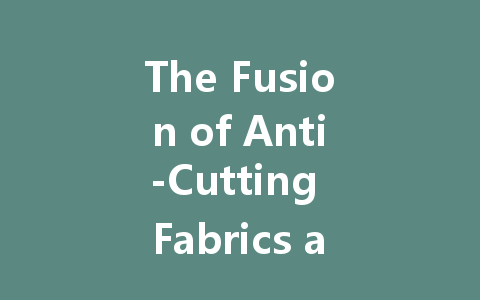In today’s rapidly evolving world, safety and innovation go hand in hand. The combination of anti-cutting fabrics and artificial intelligence (AI) is revolutionizing various industries, from personal protective equipment (PPE) to fashion, enhancing safety measures while introducing groundbreaking technologies. In this article, we will explore how this fusion is changing the game in protection and design.
Understanding Anti-Cutting Fabrics
Anti-cutting fabrics are specially engineered materials designed to resist cuts and abrasions. They are often made from high-strength fibers such as Kevlar, Dyneema, or other composite materials that offer impressive durability and protective qualities. These fabrics are commonly used in industries where workers are exposed to sharp objects, such as construction, manufacturing, and healthcare.
By integrating AI technology, the performance and functionality of these fabrics can be significantly enhanced. AI algorithms can analyze data from various sources to improve material development and optimize user safety.
The Role of Artificial Intelligence
Artificial intelligence has penetrated nearly every industry, and safety apparel is no exception. AI can process vast amounts of data, enabling the identification of patterns and trends that help improve the design and effectiveness of anti-cutting fabrics. For instance, machine learning can predict which areas of ファブリック are most likely to experience wear and tear based on user behavior and environmental conditions.
Additionally, AI can facilitate real-time monitoring of structural integrity, alerting users to potential hazards. This futuristic approach not only enhances safety but also reduces the likelihood of injuries, leading to increased productivity in workplaces.
Enhanced Design and Customization
With the integration of AI, anti-cutting fabrics can be designed and customized with a level of precision previously unattainable. AI-driven design tools can analyze individual user needs and suggest modifications tailored to specific tasks or environments. This level of customization ensures that users receive optimal protection, increasing comfort and functionality in their workwear.
Moreover, AI can help designers create visually appealing patterns while adhering to safety standards. This aesthetic enhancement opens new opportunities in the fashion world, allowing designers to break through traditional barriers of protective wear.
Smart Wearable Technology
The combination of anti-cutting fabrics and AI is leading to the emergence of smart wearable technology. By embedding sensors into protective clothing, these smart fabrics can monitor the user’s vitals, track movements, and assess environmental conditions. This data can be processed using AI algorithms to provide real-time insights into the user’s health and safety status.
For example, smart gloves made from anti-cutting materials could monitor grip strength and fatigue levels, alerting users when it’s time to take a break or adjust their technique. Such innovations are not only beneficial for individual workers but also for organizations aiming to enhance workplace safety.
Expanding Applications Across Industries
The combination of anti-cutting fabrics and AI isn’t limited to the workplace. This technology is making waves in various sectors:
Challenges and Future Prospects
While the fusion of anti-cutting fabrics and artificial intelligence offers remarkable potential, it is important to acknowledge the challenges involved. The initial integration costs can be high, and there may be a learning curve associated with using advanced technology for both manufacturers and end-users.
However, with continued research and development, we can anticipate a future where these technologies will be more accessible and affordable. As more companies recognize the benefits of utilizing AI for safety gear, we can expect an industry-wide shift toward tech-enhanced protective wear.
結論
The combination of anti-cutting fabrics and artificial intelligence is paving the way for a new era of safety, protection, and innovation. With advanced materials and smart technology working hand in hand, users can look forward to a future where safety is prioritized without sacrificing style or convenience. As we embrace this evolution in textiles and AI, we are not just protecting lives but also enriching them with intelligent design solutions.

